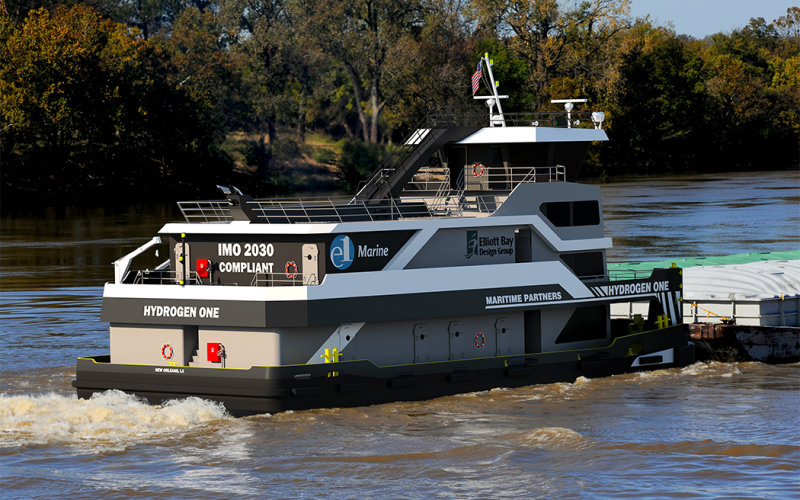The use of alternatively powered workboats is growing. Vessel owners and operators, their interest piqued by the prospect of cost-effective, environmentally friendly propulsion, continue to seek new and potentially more efficient forms of marine propulsion.
The Hydrogen One is an example of such an endeavor.
The 100'×40' hydrogen-powered towboat is scheduled to be delivered this year. That may change since this new design is still undergoing Coast Guard certification. One thing that’s certain is that the means of propulsion has not been previously used.
Hydrogen One gets its name from the fact that the vessel will be hydrogen powered, with hydrogen generated in a way not seen before in the marine world: a so-called methanol reformer will convert methanol passing through it to hydrogen that then goes into fuel cells, which generate electricity.
“This will be the first boat in the history of the world to run off that technology,” said Mike Complita at Elliott Bay Design Group, Seattle, which designed Hydrogen One for Maritime Partners, Metairie, La.
Electricity from the fuel cells can be sent straight to the thrusters or to charge the batteries, which then “can put more power into the thrusters, depending on how much energy they need,” Complita said. “So, if they need extra power, [they] draw from batteries and fuel cells, just like a hybrid would from diesel engines and batteries.” The L-drive Azimuth thrusters (with integrated electric motors) are being supplied by Karl Senner, LLC.
Maritime Partners, who describes itself as a privately held company that provides financing solutions to the domestic Jones Act maritime trade, will charter the vessel to American Commercial Barge Line, Jeffersonville, Ind. Hydrogen One will be built at Intracoastal Iron Works, Bourg, La. The charter is tentatively scheduled to begin in June 2024.
In December, Complita said the Coast Guard “was very close” to being finished with the certification process.” The Coast Guard, he noted, was being particularly careful because this type of technology has “never been done before.” As a result, he said, it will have taken two years to get through the regulatory process.
Complita noted that one difference between the Hydrogen One and the standard diesel-powered towboat is that the engine room, which is above the main deck, needs to be about one and a half times the size of a conventional engine room because of all the equipment that’s needed and all the batteries. “You need space above deck for all the new technology, where all the fuel consumption and power conversion take place.”
Thus, the below-deck space has been reconfigured for fuel storage, which has its own space issues. That’s because every type of alternative fuel is much less energy-dense than diesel. “You usually need twice as much methanol or ammonia as diesel,” Complita said.
Though it will be breakthrough technology when the Hydrogen One is launched, Complita pointed out that the Hydrogen One is not a prototype test boat. “We are building a totally working boat,” he said, though he anticipates a four- to six-month break-in period before Hydrogen One begins moving commercial cargo. As with any new adventure, “there will be hiccups with it as you learn how to operate the boat. It doesn’t operate like a conventional engine. Drop the throttle, it will have its own style.”
Hydrogen One is being viewed as a new pathway into the use of alternative fuels and alternative propulsion. “There’s a line of people waiting to sign up, once they see a working version of it and have enough confidence in its reliability,” said Complita.
HYBRID FERRIES
Senesco Marine, North Kingston, R.I., is building a pair of hybrid ferries for the Maine State Ferry Service. “They are the first-ever hybrid ferries in the Northeast,” said Senesco Marine’s Ted Williams. One will operate out of Rockland and the other from Portland.
They are Senesco Marine’s first hybrid vessels. The ferry for Rockland should be launched in the spring of 2024, while the Portland-based ferry is scheduled to be launched a few months later.
Gilbert Associates, Braintree, Mass., designed the 154'×38' Rockland ferry, the Capt. Almer Dinsmore, which will carry 250 passengers and 24 cars. At the end of December, the ferry was nearly finished. “The superstructure is built, and machinery is going in,” said Gilbert’s Jerry Gilligan.
The ferry features a BAE Systems HybriGen power and propulsion system, with a pair of 600-hp Caterpillar C-18 diesels, 150-hp electric boost motors, two Caterpillar 9.3 generators and battery banks from Spear Power Systems in Grandview, Mo. Karl Senner LLC. supplied the REINTJES Hybrid Gearboxes with clutchable PTIs to Senesco.
There’s an electric motor input to the gear and to the diesel gear. When the propeller needs full boost horsepower, the electric motor kicks in. When the boat is going slow it can be run on just electric motors, drawing from “the two generators, the batteries or a combination,” said Gilligan.
The key to the ferry’s successful operation is BAE Systems. Its power system manages the power automatically between the diesels, the electric motors, generators, and batteries.
Gilligan said the most similar vessel to the new Maine hybrid ferries is the San Francisco Red & White Fleet boat Enhydra. The Enhydra is a 128', 600-passenger excursion boat that was the largest hybrid excursion boat when it was built in 2018. It features a lithium-ion battery-electric hybrid propulsion system.
Gilbert Associates is also working on the design for a 205'×40' Maine Department of Transportation double-ended hybrid ferry.
HYBRID-READY CTVs
In January, Blount Boats Inc., Warren, R.I., was scheduled to deliver the Gripper, the first of two 100'×36'6" hybrid-ready crew transfer vessels to American Offshore Services, Providence, R.I. The second hybrid-ready boat will be delivered this summer. The twin-hull catamaran designs are powered by four Volvo Penta IPS900 propulsion drives, 800-hp each, two in each hull.
Hybrid-ready means that the vessel has been designed for conversion to hybrid power in the future. Hence, there’s space in the CTVs that Luther Blount, project engineer at Blount Boats, said would be the engine room on a normal boat. “But it’s completely empty, nothing but a few lights.” That nearly 16-foot-long area “is basically two hull voids reserved for some point in the life of the vessel, they’ll have the option of overhauling it and putting hybrid equipment in.”
The added weight of a hybrid addition is something that bothers Blount. “It’s hard to say whether the weight penalties offset the gains,” he said. “You need a lot of power and a lot of speed, and it’s hard to get that in a hybrid system with a lot of weight. In a perfect world it would be hybrid already.”





